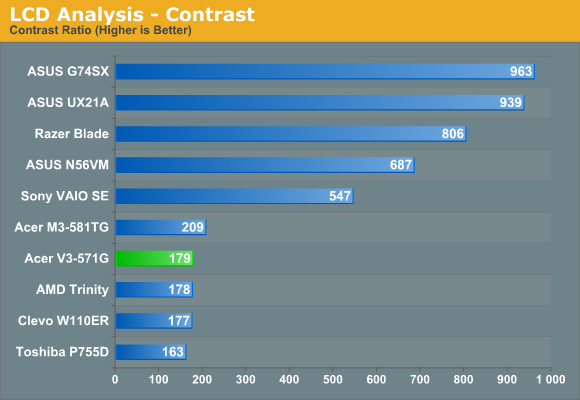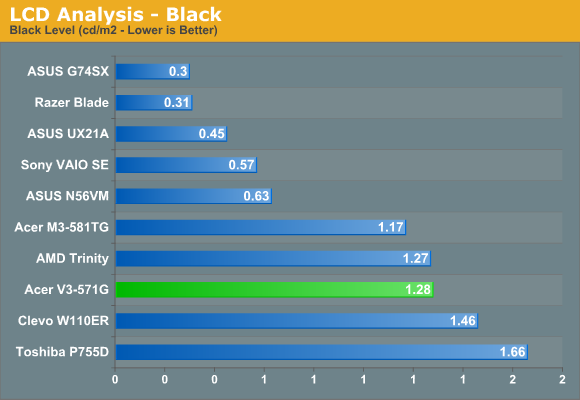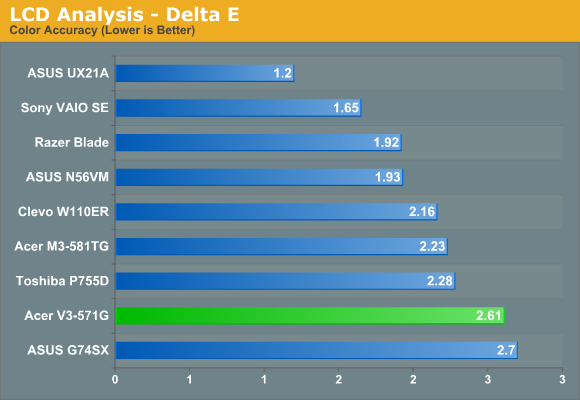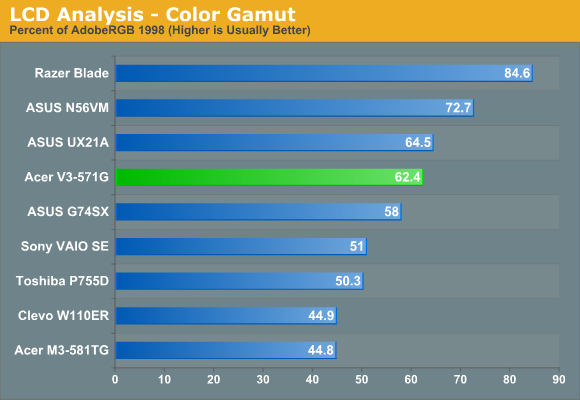Acer Aspire V3-571G-9435: The Value Proposition
by Jarred Walton on July 4, 2012 4:25 AM ESTAcer V3-571G: Just How Bad Is the LCD?
We’ve made it a habit of pointing out just how bad a lot of laptop LCDs are, and sadly (but not surprisingly) Acer’s V3 laptop does nothing to buck the trend. We’re not even hoping for something like Apple’s Retina MacBook Pro here; I’d setting for just getting a better resolution than 1366x768 on a 15.6” display, and improved contrast would be icing on the cake. The LG LP156WH4 panel sadly provides neither. First, let’s see the results.





You get very poor contrast, poor maximum brightness, and weak colors. Note that we’re reporting color accuracy after calibration—run any of the laptops without using calibration software and hardware and you’ll get a Delta E consistently in the 15-25 range. (That might seem horrible, and it is, but it’s basically the same thing you get with every single tablet right now so keep that in mind.) Viewing angles are also really poor, with massive color shifting when you view the display from above or below.
But Can You Do Anything About It?
With all the bad aspects of the LCD, I got thinking: can you replace the panel with something better? As luck would have it, I have one of my favorite LCDs from the past several years ready for just such a test, the AU Optronics B156HW01v4. This particular panel comes courtesy of LaptopScreen.com, and you can even purchase your own for just $86 right now. (The original LP156WH4 costs $65, if you’re curious—and LaptopScreens has it in glossy and matte variants if you’re interested; the B156HW01 v7 is the glossy equivalent of the v4 as well, if you prefer glossy.)
I have to say, having had two cracked LCDs on laptops during the past five or so years, the improved availability of replacements (at very reasonable prices!) is definitely welcome. Even better news: the B156HW01 fits perfectly into the Acer V3 chassis. You can see the disassembly process in the following gallery—I used an old credit card to help pry the plastic chassis apart.
That’s all great news, but sadly there’s not a happy ending to this particular story. Despite a rather complex disassembly process (and the very real potential to break off some plastic clips), even though everything fits the final result was a failure. The original display is a budget 1366x768 panel, and as best I can tell Acer uses a data cable that doesn’t support higher resolutions properly. With the B156HW01 installed, you can boot up the laptop without trouble and even select the 1920x1080 resolution within Windows, but every other column of pixels ends up being white.
Update: The technical explanation is that, much like single-link DVI vs. dual-link DVI, there are single-channel LVDS cables and dual-channel LVDS cables. Single-channel LVDS can support up to 1366x768 (1280x800), but anything beyond that requires dual-channel LVDS. That means if you get a laptop with a 1600x900 display, you can upgrade to 1080p without needing a different cable, but for laptops like the V3 that ship with a native 1366x768 panel you will likely need a different cable. The single-channel LVDS cables have eight missing (empty) wires for the second data channel, which is why every other column ended up blank. Unfortunately, I haven't had any luck finding a compatible cable for the newly launch V3-571G. If you're feeling really adventurous, you could always try to roll your own.
If you can find an appropriate data/power cable, you should be able to get the 1080p display to work properly, but I have to send this laptop back to Acer so I’m not going to spend any more effort on the attempt. In general, you should be able to replace an LCD in a laptop with any LCD that runs at the same or lower resolution (and has the same form factor—note that there are at least four different form factors/mounting mechanisms just for 15.6” screens), but for higher resolution displays you will need a laptop that is designed to support such displays. If you buy a laptop where the manufacturer supports multiple resolutions (e.g. Dell’s XPS 15z can be configured with either a 1366x768 or a 1920x1080 display), you should be able to make the upgrade as well, but ideally you’d just buy a laptop with a quality display in the first place.
When I see 1920x1200 tablets from ASUS and Acer hitting the market, or ASUS’ 1080p Ultrabooks—not to mention Apple pushing their Retina displays on all of their product lines—I keep thinking, “Maybe we’re finally going to see the end of low resolution displays.” After all, go shopping for a new HDTV and you’ll see that no one even bothers with 720p these days and the only HDTVs that aren’t 1080p (or higher) are on clearance. So why is it that our laptops are still stuck with such a low resolution? If you care about displays, my recommendation is to make sure to let your wallet do the talking, and encourage friends and relatives to do the same. (/rant)


_thumb.jpg)
_thumb.jpg)
_thumb.jpg)
_thumb.jpg)
_thumb.jpg)
_thumb.jpg)
_thumb.jpg)
_thumb.jpg)
_thumb.jpg)
_thumb.jpg)
_thumb.jpg)
_thumb.jpg)
_575px.jpg)








88 Comments
View All Comments
weiran - Wednesday, July 4, 2012 - link
Terrible display ruins a laptop.You should refuse to review 15" laptops with a resolution more suited for an 11".
JarredWalton - Wednesday, July 4, 2012 - link
If we refused to review any laptop with a marginal display, we'd be stuck with about 10 to 15 laptop reviews per year -- and that's assuming we could even get all the good display laptops in for review. We would also forego reviews of any laptop that doesn't cost at least $1000. Needless to say, the volume of laptops sold for under $800 is probably an order of magnitude more than the volume of over $1000 laptops sold, so it's an important market to at least look at.duploxxx - Wednesday, July 4, 2012 - link
no one in this budget needs that quad core horse power. Acer would be better of spending the wasted money on build quality or better screen.Penti - Wednesday, July 4, 2012 - link
On the other hand GT 640M wouldn't drive a high-res screen at native resolution. In games that is. But I'm quiet appalled that we can have chassis like this in the Ultrabook and starting configurations for business notebooks price range. Even if you don't have the best displays, or the budget to do all like a super nice case you should at least have a good touchpad and keyboard. Something like a Acer TimelineU M5 wouldn't be more expensive either. So I'm note sure what they are thinking it looks to be a much better notebook, you don't need quadcore notebooks for gaming, the trackpad looks to be better (if they don't fail at it, looks to be a cheap variant on the V3 though) at the M5 and it also comes in a 14" variant.A 2kg dualcore notebook for 800 with GT 640M should be well enough here, and does look better then this. But you loose 1GB of VRAM as well as that quadcore. Yet this doesn't look like a 800 dollar notebook from today and I think it's time to leave the plastic gamer ~800-1000 dollar notebooks behind and let compal and Clevo come up with better computers to fill that need for the OEM's or for them to take the market more seriously and design something decent themselves. Mobile gpus for mid-end performance for gaming obviously exist for half decent power and price range. I thought Acer was trying to clean up their act and please kill all the packard and gateway branding too. Those might have filled up a space in the early 90's, but it's not something you like to remember. Lots of similar stuff isn't the right thing here, if you still like to have budget lineups they will need to be more differentiated from high end models. They should still be decent enough for those that don't like to spend 800-1000 or more too.
JarredWalton - Wednesday, July 4, 2012 - link
Statements like this are so arrogant. "No one in this budget needs that quad core CPU." Really? Who made you the determiner of what every person needs? I know a lot of poor college and high school students that would like to be able to have access to more than just basic dual-core processors. Following your logic, we end up back with the old "640K should be enough for anything" mentality of the DOS era. While most people don't need and won't use the processing power of a quad-core CPU, to say that no one needs it is very narrow minded.bupkus - Wednesday, July 4, 2012 - link
I know a lot of poor college and high school students that would like to be able to have access to more than just basic dual-core processors.Good, but the question is, "can they afford it"?
We have promised to buy a nephew a notebook and had anticipated to pay no more than $500. Now I'm wondering what we can get that will allow this high school grad to do school work and just not even try to provide him gaming or media capabilities.
For that purpose a good monitor seems more significant than an i7 processor. We hope we can find just such a notebook with perhaps a dual core Sandy Bridge processor and even a decent keyboard. Intel HD 3000 display will do just fine. Only the resolution needs a little upgrade.
JarredWalton - Wednesday, July 4, 2012 - link
Obviously there's no single answer to what's most important, but For many of the components, whatever you buy with your laptop is going to be what you're stuck with until you buy a new laptop. If you buy a laptop that doesn't have a discrete GPU, it will generally be inadequate for gaming. You have a better chance of upgrading the display (see the LCD testing section where I discuss what's required) than you have of adding a discrete GPU to a laptop that doesn't come with one. Even swapping out CPUs can be a bit tricky, as you have the potential for locked down BIOS firmware that refuses to support anything besides a couple specific CPUs.Anyway, while I understand that many parents might find the lack of graphics hardware a benefit, if your son/daughter/nephew/niece/etc. ends up not liking the laptop and taking out a student loan to go buy a laptop that they do want, you've wasted money. This definitely happens, as I knew quite a few people back when I was in school that spent $1500+ from their student loans on a new PC that they "needed" for their studies. Of course, I was a CS major so they really did need a computer of some form, but I'm not so sure the 3dfx Voodoo cards were required hardware....
jabber - Wednesday, July 4, 2012 - link
True, however, if you keep reviewing these inferior screens then they will still keep coming.If you said to the manufacturers "No sorry but we consider that spec to be obsolete/inferior to what our users want to buy!" then the message may get across that things have to change.
If you only review 15 laptops a year so what? They are more likely to be ones your readers want to buy after all.
Plenty of other stuff to review than crappy screened laptops after all.
retrospooty - Wednesday, July 4, 2012 - link
"True, however, if you keep reviewing these inferior screens then they will still keep coming. If you said to the manufacturers "No sorry but we consider that spec to be obsolete/inferior to what our users want to buy!" then the message may get across that things have to change"I agree in theory, but the root cause is the issue. Having a site or two or several say that wont change anything. Manufacturers will keep making it as long as people keep buying it.
At least today there are alot more 1600x900 and 1920x1080 options in 13,14 and 15 inch laptops than there has been for the past 3 years. It's starting to shift to higher res.
JarredWalton - Wednesday, July 4, 2012 - link
Exactly. I love how I'm supposed to refuse to review laptops that 90% of people I know outside of AnandTech will buy, and in turn only review hardware that 10% or less of people I know will use. And AnandTech should apparently also only cater to the enthusiasts, rather than trying to build our audience.Articles like this can get noticed by the semi-technical readers that are researching a laptop, and they might end up saying, "Wow, there's a ton of information in that review that I can't find elsewhere. If they think this laptop is fast but cheap -- in price as well as quality -- what do they recommend as an alternative? Maybe I should read more...." We have the potential to increase knowledge as well as readership with mainstream articles like this.
It's always important to see what's going on in the budget oriented market segment when evaluating higher end offerings. I should have a few higher quality (and higher price) laptops in for review shortly, some with good/great screens and some with more of this 1366x768 nonsense.